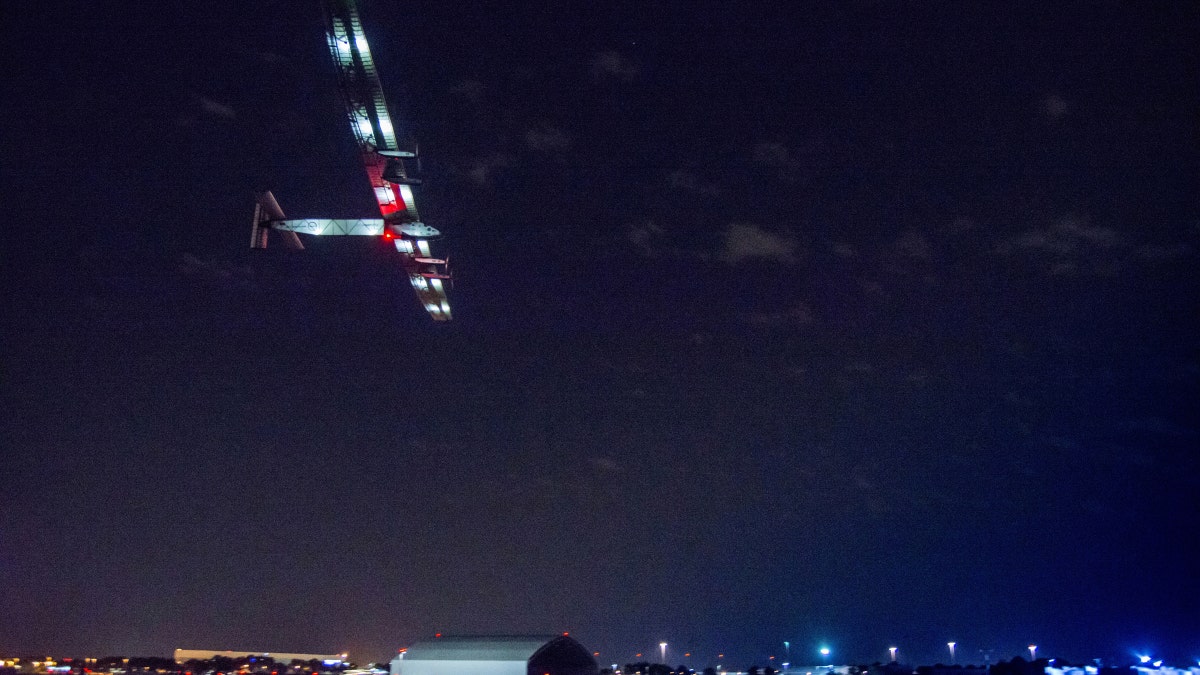
In this photo provided by Solar Impulse 2, the solar powered plane, piloted by Swiss pioneer Bertrand Piccard takes off from John F. Kennedy International Airport in New York on Monday, June 20, 2016, on its way to Southern Spain. (Jean Revillard/Solar Impulse 2 via AP)
Sophisticated nutritional science is helping fuel Solar Impulse 2 pilot Bertrand Piccard on his historic flight across the Atlantic.
Piccard took off from New York early Monday as the solar-powered plane continues its epic journey around the world. The single-seater aircraft is expected to land in Seville, Spain on Thursday.
Solar Impulse partner Nestle Research, which is devising the food for the global trip, told FoxNews.com that Piccard’s in-flight meals have been carefully developed to meet the demands of his complex flight.
The Solar Impulse pilots rely on eating soups and self-warming meals on long flights.
Gaelle Schlup, Head of Nestle Research Center’s Experimental Kitchen, says the nutritional team gained valuable insight when Piccard’s fellow Swiss pilot Andre Borschberg flew the aircraft on a record-breaking 118-hour flight from Japan to Hawaii last year. Piccard is taking it in turns with Borschberg to fly Solar Impulse 2 across the globe – from Hawaii, Piccard flew the next leg of the trip, a 62-hour journey to California.
“We had some insights from the long flight of Andre,” Schlup explained, noting that the soups provided to Piccard on the Atlantic leg have been upgraded. “We made the soups richer in energy, especially in calories – they really need fat intake at high altitude because it’s something that gives you very quick energy.”
Schlup explained that Nestle Research also changed the texture of its soups, noting that they were “a bit too liquid,” during Borschberg’s flight. Quinoa and spelt semolina, a wheat derivate, were added, she said.
Like Borschberg on his Pacific flight, Piccard has 66 meals and snacks with him, weighing 23.8 pounds. He also has 4 gallons of water and 1.6 gallons of sports drinks in the cockpit.
Piccard has one warm meal a day over the Atlantic – a choice of mushroom risotto, chicken, rice and vegetables, or potato gratin, warmed by a self-heating package. The warm meals are supplemented by soups, Nestle fitness bars and cereal with powdered milk.
The soups are consumed cold while flying at high altitude and the warm meals are eaten at lower altitudes. Schlup explained that, when flying at high altitude, it can be difficult for the pilot to warm up the self-heating packages. “It’s not safe to use the system of warming up the food above 3,500 meters (11,483 feet) – they have to really concentrate at high altitude, there’s a lot of turbulence,” she said, noting that pilots’ appetites are also lower at high altitude. “When they come below 3,500 meters they need to warm up a bit, so they have the opportunity to warm up the ready-to-eat meals.”
The in-flight menu is proving a success – Schlup said that neither Borschberg nor Piccard lost weight on their epic treks across the Pacific last year.
Nestle Research says that its work with the two pilots could drive nutritional innovation in other areas. “Maybe this type of diet, particularly coming from the ready-to-eat meals, could be good for elderly people who are in a small environment, not moving a lot,” said Schlup. “What we have learnt here could influence dietary research for the elderly.”
Follow James Rogers on Twitter @jamesjrogers




















